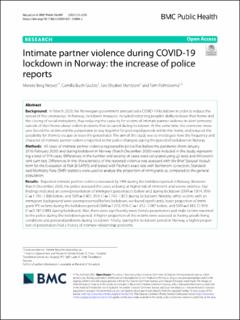| dc.description.abstract | Background In March 2020, the Norwegian government announced a COVID-19 lockdown in order to reduce the spread of the coronavirus. In Norway, lockdown measures included restricting people’s ability to leave their home and the closing of social institutions, thus reducing the capacity for victims of intimate partner violence to alert someone outside of their home about violent incidents that occurred during lockdown. At the same time, the restrictive measures forced the victim and the perpetrator to stay together for prolonged periods within the home, and reduced the possibility for them to escape or leave the perpetrator. The aim of this study was to investigate how the frequency and character of intimate partner violence reported to the police changed during the period of lockdown in Norway. Methods All cases of intimate partner violence registered in police files before the pandemic (from January 2016-February 2020) and during lockdown in Norway (March-December 2020) were included in the study, representing a total of 974 cases. Differences in the number and severity of cases were calculated using χ2-tests and Wilcoxon’s rank sum test. Differences in the characteristics of the reported violence was assessed with the Brief Spousal Assault form for the Evaluation of Risk (B-SAFER) and tested with Fischer’s exact test with Bonferroni correction. Standardised Morbidity Rate (SMR) statistics were used to analyse the proportion of immigrants as compared to the general population. Results Reported intimate partner violence increased by 54% during the lockdown period in Norway. Between March-December 2020, the police assessed the cases as being at higher risk of imminent and severe violence. Our findings indicated an overrepresentation of immigrant perpetrators before and during lockdown (SMR = 1.814, 95% CI = 1.792–1.836 before, and SMR = 1.807, 95% CI = 1.742–1.872 during lockdown). Notably, while victims with an immigrant background were overrepresented before lockdown, we found significantly lower proportion of immigrant IPV victims during the lockdown period (SMR = 1.070, 95% CI = 1.052–1.087 before, and SMR = 0.835, CI 95% CI = 0.787-0.883 during lockdown). Also, there were significantly more female perpetrators and male victims reported to the police during the lockdown period. A higher proportion of the victims were assessed as having unsafe living conditions and personal problems during lockdown. Finally, during the lockdown period in Norway, a higher proportion of perpetrators had a history of intimate relationship problems. Conclusions Intimate partner violence increased dramatically during the COVID-19 lockdown. A range of options for victims to escape from their perpetrators, particularly during times of crisis, should be developed in line with good practice, and with a special focus on the most vulnerable victims. | en_US |

